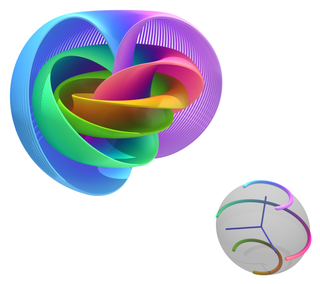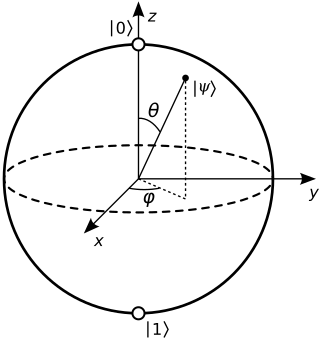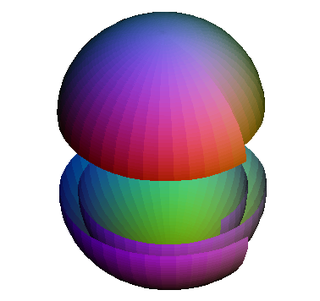In mathematics, real projective space, denoted or is the topological space of lines passing through the origin 0 in the real space It is a compact, smooth manifold of dimension n, and is a special case of a Grassmannian space.
In mathematics, real projective space, denoted or is the topological space of lines passing through the origin 0 in the real space It is a compact, smooth manifold of dimension n, and is a special case of a Grassmannian space.
As with all projective spaces, RPn is formed by taking the quotient of Rn+1 ∖ {0} under the equivalence relation x ∼ λx for all real numbers λ ≠ 0. For all x in Rn+1 ∖ {0} one can always find a λ such that λx has norm 1. There are precisely two such λ differing by sign.
Thus RPn can also be formed by identifying antipodal points of the unit n-sphere, Sn, in Rn+1.
One can further restrict to the upper hemisphere of Sn and merely identify antipodal points on the bounding equator. This shows that RPn is also equivalent to the closed n-dimensional disk, Dn, with antipodal points on the boundary, ∂Dn = Sn−1, identified.
The antipodal map on the n-sphere (the map sending x to −x) generates a Z2 group action on Sn. As mentioned above, the orbit space for this action is RPn. This action is actually a covering space action giving Sn as a double cover of RPn. Since Sn is simply connected for n ≥ 2, it also serves as the universal cover in these cases. It follows that the fundamental group of RPn is Z2 when n > 1. (When n = 1 the fundamental group is Z due to the homeomorphism with S1). A generator for the fundamental group is the closed curve obtained by projecting any curve connecting antipodal points in Sn down to RPn.
The projective n-space is compact, connected, and has a fundamental group isomorphic to the cyclic group of order 2: its universal covering space is given by the antipody quotient map from the n-sphere, a simply connected space. It is a double cover. The antipode map on Rp has sign , so it is orientation-preserving if and only if p is even. The orientation character is thus: the non-trivial loop in acts as on orientation, so RPn is orientable if and only if n + 1 is even, i.e., n is odd. [2]
The projective n-space is in fact diffeomorphic to the submanifold of R(n+1)2 consisting of all symmetric (n + 1) × (n + 1) matrices of trace 1 that are also idempotent linear transformations.[ citation needed ]
Real projective space admits a constant positive scalar curvature metric, coming from the double cover by the standard round sphere (the antipodal map is locally an isometry).
For the standard round metric, this has sectional curvature identically 1.
In the standard round metric, the measure of projective space is exactly half the measure of the sphere.
Real projective spaces are smooth manifolds. On Sn, in homogeneous coordinates, (x1, ..., xn+1), consider the subset Ui with xi ≠ 0. Each Ui is homeomorphic to the disjoint union of two open unit balls in Rn that map to the same subset of RPn and the coordinate transition functions are smooth. This gives RPn a smooth structure.
Real projective space RPn admits the structure of a CW complex with 1 cell in every dimension.
In homogeneous coordinates (x1 ... xn+1) on Sn, the coordinate neighborhood U1 = {(x1 ... xn+1) | x1 ≠ 0} can be identified with the interior of n-disk Dn. When xi = 0, one has RPn−1. Therefore the n−1 skeleton of RPn is RPn−1, and the attaching map f : Sn−1 → RPn−1 is the 2-to-1 covering map. One can put
Induction shows that RPn is a CW complex with 1 cell in every dimension up to n.
The cells are Schubert cells, as on the flag manifold. That is, take a complete flag (say the standard flag) 0 = V0 < V1 <...< Vn; then the closed k-cell is lines that lie in Vk. Also the open k-cell (the interior of the k-cell) is lines in Vk \ Vk−1 (lines in Vk but not Vk−1).
In homogeneous coordinates (with respect to the flag), the cells are
This is not a regular CW structure, as the attaching maps are 2-to-1. However, its cover is a regular CW structure on the sphere, with 2 cells in every dimension; indeed, the minimal regular CW structure on the sphere.
In light of the smooth structure, the existence of a Morse function would show RPn is a CW complex. One such function is given by, in homogeneous coordinates,
On each neighborhood Ui, g has nondegenerate critical point (0,...,1,...,0) where 1 occurs in the i-th position with Morse index i. This shows RPn is a CW complex with 1 cell in every dimension.
Real projective space has a natural line bundle over it, called the tautological bundle. More precisely, this is called the tautological subbundle, and there is also a dual n-dimensional bundle called the tautological quotient bundle.
The higher homotopy groups of RPn are exactly the higher homotopy groups of Sn, via the long exact sequence on homotopy associated to a fibration.
Explicitly, the fiber bundle is:
You might also write this as
or
by analogy with complex projective space.
The homotopy groups are:
The cellular chain complex associated to the above CW structure has 1 cell in each dimension 0, ..., n. For each dimensional k, the boundary maps dk : δDk → RPk−1/RPk−2 is the map that collapses the equator on Sk−1 and then identifies antipodal points. In odd (resp. even) dimensions, this has degree 0 (resp. 2):
Thus the integral homology is
RPn is orientable if and only if n is odd, as the above homology calculation shows.
The infinite real projective space is constructed as the direct limit or union of the finite projective spaces:
This space is classifying space of O(1), the first orthogonal group.
The double cover of this space is the infinite sphere , which is contractible. The infinite projective space is therefore the Eilenberg–MacLane space K(Z2, 1).
For each nonnegative integer q, the modulo 2 homology group .
Its cohomology ring modulo 2 is
where is the first Stiefel–Whitney class: it is the free -algebra on , which has degree 1.

In mathematics, an n-sphere or a hypersphere is a topological space that is homeomorphic to a standardn-sphere, which is the set of points in (n + 1)-dimensional Euclidean space that are situated at a constant distance r from a fixed point, called the center. It is the generalization of an ordinary sphere in the ordinary three-dimensional space. The "radius" of a sphere is the constant distance of its points to the center. When the sphere has unit radius, it is usual to call it the unit n-sphere or simply the n-sphere for brevity. In terms of the standard norm, the n-sphere is defined as
In mathematics, and more specifically in algebraic topology and polyhedral combinatorics, the Euler characteristic is a topological invariant, a number that describes a topological space's shape or structure regardless of the way it is bent. It is commonly denoted by .

In mathematics, the orthogonal group in dimension , denoted , is the group of distance-preserving transformations of a Euclidean space of dimension that preserve a fixed point, where the group operation is given by composing transformations. The orthogonal group is sometimes called the general orthogonal group, by analogy with the general linear group. Equivalently, it is the group of orthogonal matrices, where the group operation is given by matrix multiplication. The orthogonal group is an algebraic group and a Lie group. It is compact.
In mathematics, specifically in homology theory and algebraic topology, cohomology is a general term for a sequence of abelian groups, usually one associated with a topological space, often defined from a cochain complex. Cohomology can be viewed as a method of assigning richer algebraic invariants to a space than homology. Some versions of cohomology arise by dualizing the construction of homology. In other words, cochains are functions on the group of chains in homology theory.

In mathematics, the concept of a projective space originated from the visual effect of perspective, where parallel lines seem to meet at infinity. A projective space may thus be viewed as the extension of a Euclidean space, or, more generally, an affine space with points at infinity, in such a way that there is one point at infinity of each direction of parallel lines.
In mathematics, conformal geometry is the study of the set of angle-preserving (conformal) transformations on a space.
A CW complex is a kind of a topological space that is particularly important in algebraic topology. It was introduced by J. H. C. Whitehead to meet the needs of homotopy theory. This class of spaces is broader and has some better categorical properties than simplicial complexes, but still retains a combinatorial nature that allows for computation. The C stands for "closure-finite", and the W for "weak" topology.

In the mathematical field of differential topology, the Hopf fibration describes a 3-sphere in terms of circles and an ordinary sphere. Discovered by Heinz Hopf in 1931, it is an influential early example of a fiber bundle. Technically, Hopf found a many-to-one continuous function from the 3-sphere onto the 2-sphere such that each distinct point of the 2-sphere is mapped from a distinct great circle of the 3-sphere. Thus the 3-sphere is composed of fibers, where each fiber is a circle — one for each point of the 2-sphere.

In quantum mechanics and computing, the Bloch sphere is a geometrical representation of the pure state space of a two-level quantum mechanical system (qubit), named after the physicist Felix Bloch.

In mathematics, complex projective space is the projective space with respect to the field of complex numbers. By analogy, whereas the points of a real projective space label the lines through the origin of a real Euclidean space, the points of a complex projective space label the complex lines through the origin of a complex Euclidean space (see below for an intuitive account). Formally, a complex projective space is the space of complex lines through the origin of an (n+1)-dimensional complex vector space. The space is denoted variously as P(Cn+1), Pn(C) or CPn. When n = 1, the complex projective space CP1 is the Riemann sphere, and when n = 2, CP2 is the complex projective plane (see there for a more elementary discussion).
In mathematics, in particular in algebraic topology and differential geometry, the Stiefel–Whitney classes are a set of topological invariants of a real vector bundle that describe the obstructions to constructing everywhere independent sets of sections of the vector bundle. Stiefel–Whitney classes are indexed from 0 to n, where n is the rank of the vector bundle. If the Stiefel–Whitney class of index i is nonzero, then there cannot exist everywhere linearly independent sections of the vector bundle. A nonzero nth Stiefel–Whitney class indicates that every section of the bundle must vanish at some point. A nonzero first Stiefel–Whitney class indicates that the vector bundle is not orientable. For example, the first Stiefel–Whitney class of the Möbius strip, as a line bundle over the circle, is not zero, whereas the first Stiefel–Whitney class of the trivial line bundle over the circle, , is zero.
In mathematics, specifically algebraic topology, an Eilenberg–MacLane space is a topological space with a single nontrivial homotopy group.

In the mathematical field of algebraic topology, the homotopy groups of spheres describe how spheres of various dimensions can wrap around each other. They are examples of topological invariants, which reflect, in algebraic terms, the structure of spheres viewed as topological spaces, forgetting about their precise geometry. Unlike homology groups, which are also topological invariants, the homotopy groups are surprisingly complex and difficult to compute.
In mathematics, cellular homology in algebraic topology is a homology theory for the category of CW-complexes. It agrees with singular homology, and can provide an effective means of computing homology modules.
In mathematics, specifically in algebraic topology, the Euler class is a characteristic class of oriented, real vector bundles. Like other characteristic classes, it measures how "twisted" the vector bundle is. In the case of the tangent bundle of a smooth manifold, it generalizes the classical notion of Euler characteristic. It is named after Leonhard Euler because of this.
In projective geometry and linear algebra, the projective orthogonal group PO is the induced action of the orthogonal group of a quadratic space V = (V,Q) on the associated projective space P(V). Explicitly, the projective orthogonal group is the quotient group
In geometry, a (globally) projective polyhedron is a tessellation of the real projective plane. These are projective analogs of spherical polyhedra – tessellations of the sphere – and toroidal polyhedra – tessellations of the toroids.

In mathematics, the Riemann sphere, named after Bernhard Riemann, is a model of the extended complex plane: the complex plane plus one point at infinity. This extended plane represents the extended complex numbers, that is, the complex numbers plus a value for infinity. With the Riemann model, the point is near to very large numbers, just as the point is near to very small numbers.
In algebraic topology, the nth symmetric product of a topological space consists of the unordered n-tuples of its elements. If one fixes a basepoint, there is a canonical way of embedding the lower-dimensional symmetric products into the higher-dimensional ones. That way, one can consider the colimit over the symmetric products, the infinite symmetric product. This construction can easily be extended to give a homotopy functor.